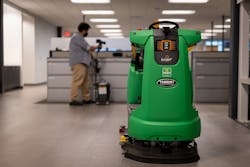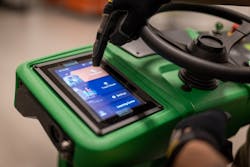The Next Cleaning Revolution: Autonomous Mobile Robot Scrubbers
Self-providers and building service contractors in charge of cleaning and implementing floor care solutions often face challenges with labor shortages and/or limited skill sets that result in cleaning inconsistencies. Even more concerning is when cleaning gaps occur that result in unhealthy environments due to dirt overload.
For that reason, many are turning to mechanized cleaners, such as automatic scrubbers, which provide productivity improvements over the mop-and-bucket approach. Yet, efficient as they may be, conventional automatic scrubbers still require direct human operation and oversight.
That’s where autonomous mobile robots (AMRs) come into play. They provide the use of a machine to enhance the capabilities of an individual without requiring hands-on human operation.
AMRs (often referred to as cobots) have only been on the market for few years. While they are not as prevalent in the cleaning industry as other solutions are, they are poised to increase in popularity.
According to ABI Research, 150,000 new mobile robots will be deployed in brick-and-mortar stores by 2025, and the use of cobots is expected to grow 46% annually through 2030. ABI also anticipates a 30% increase in productivity due to robotics across all industries, including cleaning, in the next 10 years.
Why the pending shift?
[Related: How Mechanized Cleaning Improves Productivity and Safety]
A Look at the Current Situation
Without a doubt, COVID-19 has had a significant—and likely indelible—impact on the way facilities approach cleaning and floor care. The pandemic has brought forth a heightened awareness of cleaning protocols for health and appearance, particularly more task-oriented ones. This, in turn, decreases the bandwidth of cleaning teams as the scope of work requires additional levels of cleaning, sanitizing and disinfecting multiple times a day. High-touch cleaning adds to daily requirements.
These challenges hold true for both in-house service providers and building service contractors, who also face reductions in labor as heightened awareness of COVID-19 symptoms causes absenteeism. Add this to an already tight labor pool and cleaning teams are left shorthanded, creating an overall strain on the cleaning industry.
COVID-19 isn’t solely responsible for these labor issues, however; they existed before the pandemic and likely will after.
According to a whitepaper published by the Tennant Company, “The Robotics Revolution and Your Cleaning Business,” the cleaning industry faces high turnover and significant competition for quality services. In fact, they estimate “the average cleaning company loses up to 55% of its customer base every year due to poor service.”
Introducing AMRs to combat such issues may seem somewhat disruptive to the cleaning industry—with many initially skeptical about adopting the technology—but the likelihood of these machines driving a cleaning revolution is real.
For the right facility self-provider or building service contractor, AMRs could be a positive next step to establishing higher levels of productivity, maximizing labor, and gaining visibility into performance metrics that can inform the business of better cleaning—and create safer and healthier spaces for everyone.
Putting AMRs to Work
AMRs are available in smaller units designed for retail, educational and smaller commercial spaces, as well as larger models for industrial facilities and warehouses.
They all operate under the same principle: The machine takes on the repetitive task of floor cleaning autonomously while team members are free to focus on value-added activities that increase productivity.
It’s important to remember, however, that AMRs are never intended to replace the work of humans; they are there to augment it. An employee will always be needed to work side by side with the cobot to bring cleaning to its highest potential.
AMRs operate through a connection between the machine and the employee’s smart device. Once linked, the team member sets the robotic cleaner to its task—autonomous scrubbing, mopping or sweeping—in a designated area. The employee can immediately move to other parts of the facility to focus on detailed cleaning and disinfecting, manage inventory or work on another project. The machine will check in as needed, including when it has completed its programmed task. If there are any issues during its operation, including stoppages, an alert will be sent to the employee’s cell phone or other connected smart device.
The Value of Telemetry
In addition to supporting productivity initiatives, robotic cleaning machines provide full transparency by way of telemetry—the process of recording and transmitting readings of the machine’s key performance indicators (KPIs). In short, telemetry provides proof of performance.
This is achieved in several ways.
- Heat mapping: The machine can provide a heat map of the square footage of flooring cleaned and to what extent to be sure the job has been completed satisfactorily. It also shows all other areas in the facility where the scrubber has been.
- Video: The machine can capture video of its operations. In the unlikely event of a collision, everything is recorded so self-providers or building service contractors can assess liability and any resulting machine or property damage.
- Data: The machine can provide reports at the end of the job, making it easy to understand what tasks were completed, how long it took and more.
Telemetry offers these metrics in both manual and automation mode, creating validation of the cleaning.
[Related: IAQ Gets an Upgrade During COVID-19]
Setting Up for Success
When introducing AMRs and coboting into a cleaning operation, there are several best practices to consider.
1. Establish a positive cobot mentality among the team so employees understand that the technology is not there to replace them. Rather, it is a collaborative approach to cleaning that requires human interaction.
2. Understand the capabilities of the machine and what job needs to be done. For example, robots don't operate well on reflective surfaces, so take into account the type of flooring that needs to be cleaned.
3. Map out the facility. Be sure that the robot understands the areas it will clean and is able to access them. Keep in mind that it could take a few days or even a week to properly map out the facility.
Once everything is planned and the robotic cleaning machine has begun its work, it’s important to evaluate the reports the machine provides to gain a clear understanding of the data. This allows for changes in programs to get the desired KPIs.
Making the Switch
As with any equipment, cost is always a consideration. There needs to be enough work to justify the investment in AMR technology, which is where rental can help. Renting the equipment is often more cost-effective than purchasing outright, especially if there is uncertainty about the number of projects where it would be implemented. Rental also reduces the total cost of ownership because maintenance is taken care of by the rental partner. These partners can also help with the robotic cleaner selection and offer training.
Training is especially important to gain the level of efficiency, service and productivity sought through AMRs and to help self-providers and building service supervisors be successful.
And finally, there is flexibility with the technology. As new AMR units are introduced into the marketplace, a rental model makes it easy to trade up or down in size or scale or address seasonal needs.
About the Authors:
Adam Camhi is the vice president and Rory Saleh is the director of sales - flooring solutions for Sunbelt Rentals.
Read next: Return to Work: The New Ways Companies Are Investing in Health and Wellness
About the Author

Contributed Author
BUILDINGS partners with industry experts to bring you contributed content covering the hot topics for building owners and facility professionals.

